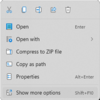I've become rather addicted to unattended installation and related topics with Win 10 thanks to tutorials from Kari.
However, there is currently a big "gotcha" with Windows 10 and I'm curious to find out if the ADK for Windows 11 will solve this.
Bear with me, I need to provide a little background to explain this...
Microsoft's latest recommendations are that the recovery partition be placed on the drive last, after the partition where Windows is installed. In fact, if you do a normal installation of Windows, this is how it will be installed.
However, when you perform an unattended installation, you provide in the answer file information regarding how many partitions to create and what size to make each partition. For each partition you would specify a size for that partition, except for the Windows partition. For that partition, you instruct unattended setup to use all remaining space on the disk. As a result, there is no space left on the drive to allow you to create the recovery partition after the Windows partition. Because of this, with an unattended installation you would typically have to create the recovery partition before the Windows partition. This works fine but it just bugs me that it doesn't follow the latest guidance from Microsoft.
You could go about calculating exactly how much space is on the disk and specify a precise size for the Windows partition to leave space afterward for the recovery partition, but that would mean performing new calculations and modifying the answer file every time you use a different size disk.
I do have a workaround in place for this, but it is not at all simple. It involves injecting batch files into the WinPE image on the install media and modifying the answer file to run these at the very beginning of the installation process. In fact, I had to write a program to do this for me because it's such a pain in the keister to do manually all the time.
So all that background simply leads me to this question:
I wonder if Microsoft has something planned for unattended setup of Windows 11 that will allow you to create the Windows partition and then leave space sufficient to allow the creation of the recovery partition at the end of the disk.
I'm not expecting any answers to this now, but for anyone who may be playing with a pre-release ADK and Win 11 unattended installation, I'd appreciate hearing if you run into a way to do this.
However, there is currently a big "gotcha" with Windows 10 and I'm curious to find out if the ADK for Windows 11 will solve this.
Bear with me, I need to provide a little background to explain this...
Microsoft's latest recommendations are that the recovery partition be placed on the drive last, after the partition where Windows is installed. In fact, if you do a normal installation of Windows, this is how it will be installed.
However, when you perform an unattended installation, you provide in the answer file information regarding how many partitions to create and what size to make each partition. For each partition you would specify a size for that partition, except for the Windows partition. For that partition, you instruct unattended setup to use all remaining space on the disk. As a result, there is no space left on the drive to allow you to create the recovery partition after the Windows partition. Because of this, with an unattended installation you would typically have to create the recovery partition before the Windows partition. This works fine but it just bugs me that it doesn't follow the latest guidance from Microsoft.
You could go about calculating exactly how much space is on the disk and specify a precise size for the Windows partition to leave space afterward for the recovery partition, but that would mean performing new calculations and modifying the answer file every time you use a different size disk.
I do have a workaround in place for this, but it is not at all simple. It involves injecting batch files into the WinPE image on the install media and modifying the answer file to run these at the very beginning of the installation process. In fact, I had to write a program to do this for me because it's such a pain in the keister to do manually all the time.
So all that background simply leads me to this question:
I wonder if Microsoft has something planned for unattended setup of Windows 11 that will allow you to create the Windows partition and then leave space sufficient to allow the creation of the recovery partition at the end of the disk.
I'm not expecting any answers to this now, but for anyone who may be playing with a pre-release ADK and Win 11 unattended installation, I'd appreciate hearing if you run into a way to do this.
My Computers
System One System Two
-
- OS
- Win11 Pro 23H2
- Computer type
- PC/Desktop
- Manufacturer/Model
- Home Built
- CPU
- Intel i7-11700K
- Motherboard
- ASUS Prime Z590-A
- Memory
- 128GB Crucial Ballistix 3200MHz DRAM
- Graphics Card(s)
- No GPU - CPU graphics only (for now)
- Sound Card
- Realtek (on motherboard)
- Monitor(s) Displays
- HP Envy 32
- Screen Resolution
- 2560 x 1440
- Hard Drives
- 1 x 1TB NVMe Gen 4 x 4 SSD
1 x 2TB NVMe Gen 3 x 4 SSD
2 x 512GB 2.5" SSDs
2 x 8TB HD
- PSU
- Corsair HX850i
- Case
- Corsair iCue 5000X RGB
- Cooling
- Noctua NH-D15 chromax.black cooler + 10 case fans
- Keyboard
- CODE backlit mechanical keyboard
- Mouse
- Logitech MX Master 3
- Internet Speed
- 1Gb Up / 1 Gb Down
- Browser
- Edge
- Antivirus
- Windows Defender
- Other Info
- Additional options installed:
WiFi 6E PCIe adapter
ASUS ThunderboltEX 4 PCIe adapter
-
- Operating System
- Win11 Pro 23H2
- Computer type
- Laptop
- Manufacturer/Model
- Lenovo ThinkBook 13x Gen 2
- CPU
- Intel i7-1255U
- Memory
- 16 GB
- Graphics card(s)
- Intel Iris Xe Graphics
- Sound Card
- Realtek® ALC3306-CG codec
- Monitor(s) Displays
- 13.3-inch IPS Display
- Screen Resolution
- WQXGA (2560 x 1600)
- Hard Drives
- 2 TB 4 x 4 NVMe SSD
- PSU
- USB-C / Thunderbolt 4 Power / Charging
- Mouse
- Buttonless Glass Precision Touchpad
- Keyboard
- Backlit, spill resistant keyboard
- Internet Speed
- 1Gb Up / 1Gb Down
- Browser
- Edge
- Antivirus
- Windows Defender
- Other Info
- WiFi 6e / Bluetooth 5.1 / Facial Recognition / Fingerprint Sensor / ToF (Time of Flight) Human Presence Sensor





















